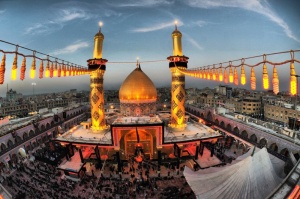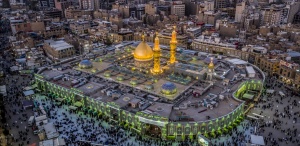Abbas B. Ali B. Abu Taleb: Difference between revisions
No edit summary |
(No difference)
|
Revision as of 10:24, 4 August 2022
Abbas B. ʿAli B. Abu Taleb | |
|---|---|
 Shrine of Abbas B. ʿAli B. Abu Taleb | |
| Native name | العبّاس بن علی |
| Born | Sha'ban 4, Islamic calendar 26 AH Medina, Hejaz (now in Saudi Arabia) |
| Died | Muharram 10 ,Islamic calendar 61 AH Karbala; Umayyad Empire (now in Iraq) |
| Cause of death | Martyrdom during the Battle of Karbala by Yazid I's men while bringing some water from Euphrates river for the family of Muhammad |
| Resting place | Al Abbas Mosque (Shrine of Abbas), Karbala, Iraq |
| Residence | Medina, Hejaz (now in Saudi Arabia) |
| Nationality | Hejaz- Hejazi Arab |
| Known for | Battle of Karbala |
| Title | أبو الفضل، قمر بنی هاشم، السقى، علمدار، شہنشاہِ وفا، باب الحسین، باب الحوائج |
| Opponent(s) | Yazid I |
| Spouse(s) | Lubaba bint Ubaydillah |
| Children | Ubaydullah ibn Abbas (died in the Battle of Karbala), Fadl ibn Abbas, Mohammad ibn Abbas (died in the Battle of Karbala) |
| Parent(s) | Ali, Ummul Banin (known as the mother of the sons only) |
| Relatives | Hasan ibn Ali (paternal half-brother), Hussain ibn Ali (paternal half-brother), Zaynab bint Ali (paternal half-sister), Umm Kulthum bint Ali (paternal half-sister), Muhsin ibn Ali (paternal half-brother), Muhammad |
| Family | Banu Hashim, Banu Kilab |
Abbas B. Ali B. Abu Taleb (d. 61/680), known as Abu Fadl (father of excellence) and Qamar Bani l-Hashim (the Moon of Banu Hashim), was a half-brother of Imam Hussain who fought bravely at the battle of Karbala. Abbas was killed, according to most traditions, on the day of Tasu'a (9 Muharram 61/10 October 680) while trying to bring back water from the Euphrates river to quench the unbearable thirst of the besieged Ahl-e Bayt. His mother, the daughter of Hizam b. Khalid b. Rabi’a from the Arab tribe of Banu Kilab, was the mother of three more sons of Ali b. Abi Talib, and for this reason she became known as Umm al-Banin. All three brothers of Abbas were killed just before him in the same battle: Abdallah, Jaʿfar, and Othman.[1]
The Battle of Karbala
As in the case of other martyrs of Karbala, the heroic conduct and death of this outstanding figure have given rise, in both Sunni and Shiʿi circles, to legendary accounts from which it is very hard to unravel the historical truth. The major difficulty arises from the fact that the main primary sources on the events of Karbala (Tabari and Baladhori) do not mention the details of Abbas’s death. A brief reference by Shaykh al-Mufid says that, in the ultimate episode of the battle, Abbas went together with Hussain toward the river; separated from his brother, he fought boldly before being killed.
Aftermath of Karbala
His body was buried by people from Banu Asad at the place where he was killed and where his tomb (and later his shrine) was erected.[2] As in the case of other martyrs of Karbala, his head was brought to Yazid in Damascus. One tradition claims that his head was later buried in the cemetery of Bab al-Saqir in Damascus.
Abbas’s Epic
The early evolution of his saga is difficult to trace, although his nickname Saqqa (“Water Carrier”) appears in ancient sources.[3] The traditions later followed regarding the circumstances of his martyrdom seem to go back to a nucleus of narratives popular in circles practicing fotovvat (a kind of chivalry) in the late Abbasid period; these spread to Turco-Persian areas among various socioreligious groups (akhi, fetyan, etc.) and ultimately among Sufi orders. Most of these narratives are known by their titles, but an idea of their contents may be gathered from the Arabic historical romance of Ibn Taʾus al-Taʾusi.[4] Its author claims to transmit traditions from Abu Mekhnaf, the main authority for most historical writings on the period. According to this account—which may reflect some historical truth—’Abbas was killed on the eve of Ashura in a desperate attempt to provide water for the besieged. Fighting alone against numerous foes, he had his right hand severed by a sword cut, then the left; seizing his sword in his mouth, he went on fighting until he was killed. Rawzat al-Shuhada[5] is the major source for the recitation of the passions of the martyrs of Karbala during the mourning months (rawza-khani). Its author, Hussain Vaʾez Kashefi, seems to follow the “historical” tradition more strictly than other writers by mentioning Abbas’s death on 10 Muharram and by shuffling the chronology only slightly, making Abbas the sixty-eighth martyr (before Muhammad b. Ali, Ali-Akbar and Ali-Asqar). Nevertheless, Kashefi mentions Abbas’s heroic sally on 9 Muharram and follows essentially the “Mesopotamian” tradition regarding the water motif.[6]
He is often called by his konya, Abu Fadl, or by his nickname, Qamar Bani Hashem (“Moon of the Hashemites”). Abbas is said to have inherited Ali’s boldness, to have always carried the victorious standard on the battlefield (thence his surname Alam-dar, “Standard-Bearer”), and to have killed many enemies (eighty, according to the Rawzat al-shuhada) before being martyred. Traditions say that when Hussain heard him cry at the last gasp he uttered the words: “My backbone is broken.” The names of his murderers, Zayd b. Varqaʾ Hanafi and Hakim b. al-Tofayl Sanani[7], are sometimes erroneously transmitted by popular narratives.
Abbas in Mourning Rituals
As one of the central participants in the drama of Karbala, Abbas is celebrated both in taʿziya and related Muharram mourning rituals as the water carrier of the Ahl-e Bayt and the standard-bearer of Hussain. A certain parallel has been noticed between Muhammad b. al-Hanafiya—standard-bearer and champion of Ali in his own saga—and Abbas fulfilling the same warrior functions near Hsayn, who is seen as essentially involved in a spiritual combat.[8] Taʿziya scripts dedicate a complete cycle to Abbas’s deeds from birth to martyrdom.[9] From the blessing (baraka) attached to his person derive some “miracle” themes celebrated in taʿziya. The representation of his martyrdom, generally performed on the eve of Ashura (i.e., the evening of the ninth day, Tasuʿa), features the most dramatic scenes found in taʿziya acting, particularly the scene picturing the veiled Abbas testing Ali-Akbar’s valor. There is even a kind of theater the story of a purported Hindu actor playing the role of Abbas.[10]
Abbas in Popular Culture
The cult of Abbas incorporates many features related to water and fertility. In Kashefi’s Fotovvatnama-ye soltani[11], he ranks in the selsela (lineage) of the saqqa saints, second in line after Ali; those who, out of devotion for the martyrs of Karbala, become saqqa, i.e., give water to the thirsty as an act of charity, “do it in imitation of Abbas-e Ali.” But there is no mention of his name in a later treatise on water carriers popular in Indo-Persian corporations.[12] Invocations such as “Ya Hazrat-e Abbas!” (O, exalted Abbas) or “Ya Abu’l-Fazl!” are generally engraved on the metal hand (panja) with outstretched fingers symbolizing the Ahl-e Bayt fixed on top of the standards (alam) carried in Muharram processions. Special votive ribbons are attached to these alams, and ex-votos are brought to their bases by women on the eve of Ashura to obtain protection for their infant children. Parents dedicate their young sons to the activity of supplying water to attendants at the Moharram ceremonies in memory of Hazrat-e Abbas. Such acts fulfill vows made when seeking children’s recovery from illness. Devotees used to offer special oblation (nadhr) consisting of a certain amount of bread and yoghurt—nan o mast, colloquially nun-o-mas (nadhr-e Hazrat-e Abbas)—to be increased each year. Other widespread practices of invocation to Abbas have been observed in Persia. Thus, to avenge oneself or to harm somebody, one may say: “Ya Hazrat-e Abbas!” or “Hazrat-e Abbas kur-et kone!” (“May H. A. blind you!”).It seems that in recent years the making of a vow in relation to Abbas has become more common among women, who, to fulfill a vow, organize religious gatherings called sofra Hazrat-e Abbas, during which food is shared.[13]
Abbas’s likeness, generally as a warrior riding his white stallion, has been represented in many ways (sometimes while cleaving his enemies to the waist with a single blow of his sword) in frescoes, paintings on wooden tablets, glass, and cloth (qalamkar), oil-painted shamayel used for pardadari (q.v.), on standards, in ceramics, lithographed illustrations, and so on. Saqqakhanas (water fountains), often built near a tekya (hall for the Moharram ceremonies), are generally dedicated to Hazrat-e Abbas. Such votive chapels (few are extant) are sometimes decorated with tilework (kashikari) scenes depicting Abbas’s heroic deeds and martyrdom similar to those found on tekya walls.
Shrine of al- Abbas
Abbas’s shrine is located in the town of Karbala on the northeast side of Imam Hussain’s mausoleum. Both shrines are built on a mound overlooking the town. Since they are visited by many pilgrims practically all year long, both have numerous servants (sayyeds, mollas, etc.) for upkeep and administration. Abbas’s shrine is built in a vast enclosure. Access to it is obtained through a succession of portals richly decorated with stalactites and enameled tiles, some of which copy ancient originals. The grave itself, covered with a golden dome (formerly an enameled faience cupola), has been recently renovated (1385/1965-66). As is the case for other martyrs of Karbala, there are special prayers and rituals to be performed at his grave; and important Muslim personalities (olamaʾ, sultans, ministers, are buried in the precinct of his shrine.
References
- ↑ Mofid, loc. cit.; Dinavari, al-Akhbar al-tewal, Cairo, 1330/1911-12, pp. 254f.
- ↑ al-Ershad, Tehran, 1377/1957-58, pp. 224-25, 227.
- ↑ Mufid, al-Ekhtesas, Tehran, 1379/1959-60, p. 82.
- ↑ tr. F. Wüstenfeld, Der Tod des Husein ben ʿAli und die Rache, Göttingen, 1883.
- ↑ q.v.; completed in 908/1502-03.
- ↑ ed. Ramazani, Tehran, 1341 Sh./1962.
- ↑ al-Ershad.
- ↑ bibliog.: Calmard, p. 368, n. 813.
- ↑ bibliog.: Rossi and Bombaci, Elenco.
- ↑ ʿAbbas-e Hendi, Elenco, no. 3.
- ↑ ed. M. J. Mahiub, Tehran, 1350 Š./1971.
- ↑ A. M. Kassim, “Etudes sur les corporations musulmanes indo-persanes,” REI, 1927, pp. 249f.
- ↑ Gustav Thaiss, “Religious Symbolism and Social Change: The Drama of Husain,” in Scholars, Saints and Sufis, ed. Nikki R. Keddie, Berkeley and Los Angeles, 1972, pp. 352ff.
Bibliography
- Eugène Aubin, La Perse d’aujourd’hui, Paris, 1908, pp. 376f.
- Ivar Lassy, The Muharram Mysteries among the Azerbeijan Turks of Caucasia, Helsingfors, 1916, pp. 38f., 52, 113, etc. Jaffur Shureef, Islam in India, or the Qanun-i Islam , tr. Herklots, Oxford, 1921, pp. 160, 162.
- Henri Massé, Anthologie persane, Paris, 1950, pp. 390-92.
- Ettore Rossi and Alessio Bombaci, Elenco di drammi religiosi persiani (fondo mss. Vaticani Cerulli), Vatican City, 1961 (on the Chodzko, Pelly, and Litten collections, see index, pp. 354f.).
- Javād Ṣafīnežād, Ṭālebābād (monograph on a village), Institute of Social Studies and Researches, no. 38, Tehran, 1345 Š./1966, p. 446.
- Peter Chelkowski, Tārīḵ va ǰanba-ye adabī-e taʿzīa (diss., University of Tehran, 1347 Š./1968), pp. 180-92.
- Hassan ul-Ameene, Islamic Shiʿite Encyclopaedia IV, Beirut, 1973, pp. 172, 180f., 192, 197, 209f.
- Jean Calmard, Le cult de l’ Imām Ḥusayn: étude sur la commémoration du drame de Karbala dans l’Iran pré-safavide (diss., University of Paris [Sorbonne], 1975), pp. 347, 364, 368f., and index (for late popular narratives). Originally Published: December 15, 1982. Last Updated: July 13, 2011. This article is available in print. Vol. I, Fasc. 1, pp. 77-79.
